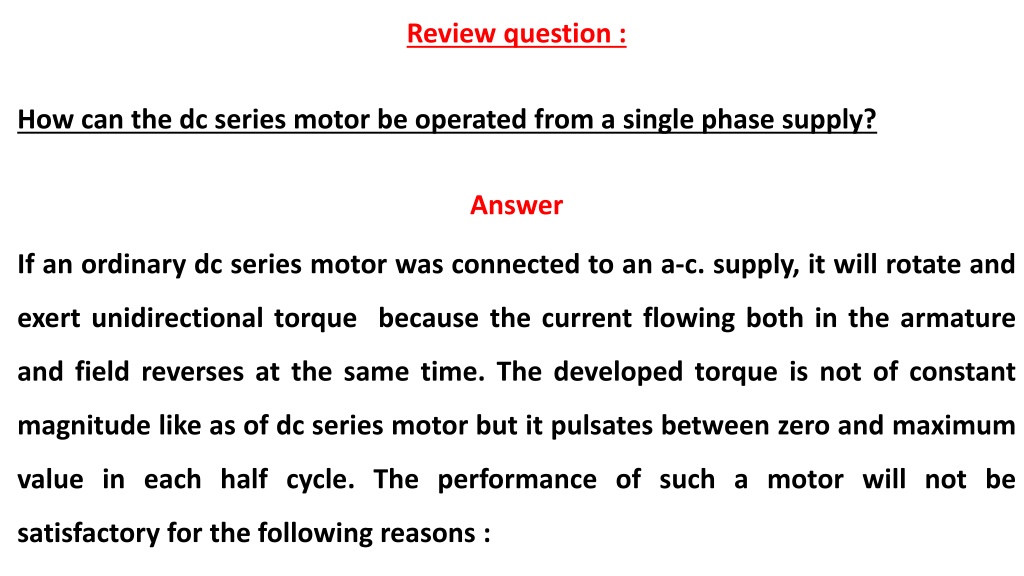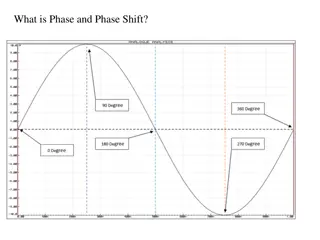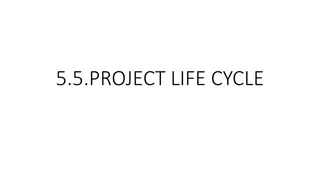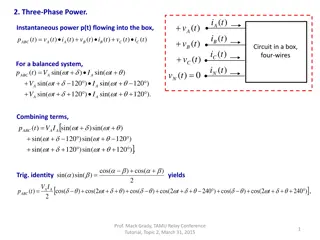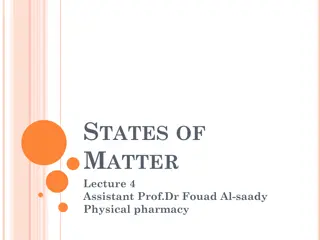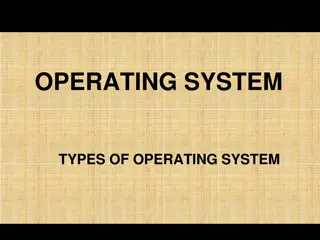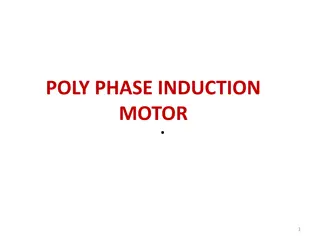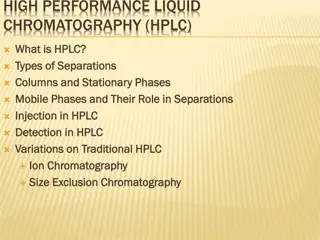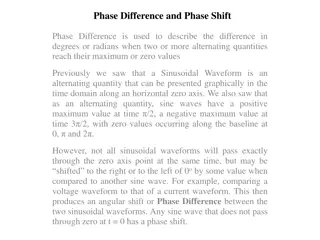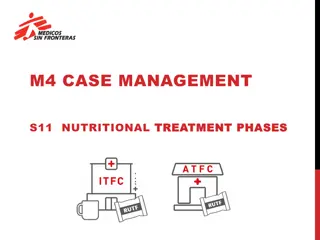Operating a DC Series Motor from a Single Phase Supply
Connecting a DC series motor to an AC supply results in pulsating torque due to reversed current flow. This setup leads to inefficiencies and challenges such as eddy current losses and poor power factor. To improve performance, modifications like laminating core structures, using compensated windings, and interpole windings are suggested. Alternatively, Repulsion Motors offer a solution based on repulsion between magnetic fields for efficient operation and torque control. Understanding the torque-brush angle characteristic is key for optimizing motor performance in such setups.
Download Presentation

Please find below an Image/Link to download the presentation.
The content on the website is provided AS IS for your information and personal use only. It may not be sold, licensed, or shared on other websites without obtaining consent from the author.If you encounter any issues during the download, it is possible that the publisher has removed the file from their server.
You are allowed to download the files provided on this website for personal or commercial use, subject to the condition that they are used lawfully. All files are the property of their respective owners.
The content on the website is provided AS IS for your information and personal use only. It may not be sold, licensed, or shared on other websites without obtaining consent from the author.
E N D
Presentation Transcript
Review question : How can the dc series motor be operated from a single phase supply? Answer If an ordinary dc series motor was connected to an a-c. supply, it will rotate and exert unidirectional torque because the current flowing both in the armature and field reverses at the same time. The developed torque is not of constant magnitude like as of dc series motor but it pulsates between zero and maximum value in each half cycle. The performance of such a motor will not be satisfactory for the following reasons :
The ac flux would cause excessive eddy current loss in the yoke and field cores which will become extremely heated. Vicious sparking will occur at brushes because of the huge voltage and current induced in the short-circuited armature coils during the commutation period. Power factor is low because of the reactance voltage drop. In order to improve the motor performance: a) laminating the iron structure of the core and yoke. b) reducing the reactance of the field windings by reducing the number of turns.
c) Using compensated winding in series with armature to overcome the armature reaction. d) Using interpole winding to reduce sparking at brushes.
Repulsion Motor Ordinary Repulsion motor: a) It consists of single phase stator winding like the main winding of the split phase induction motor. b) The rotor looks like the armature of the dc machine with short circuited brushes. c) There is no electrical connection between the stator and the rotor.
Principle of operation : Repulsion motors are based on the principle of repulsion between two magnetic fields. If the brush axis is displaced at an angle to the stator magnetic axis, a net emf is induced at the brush terminals. The emf produces current in a direction such that it creates N-pole at the top and S-pole at the bottom. The poles of the stator will repel with the poles of the armature, therefore, the motor starts rotating.
Torque brush angle characteristic : The value of starting torque developed by such a motor will depend on the amount of brush-shift. Maximum starting torque is developed at an angle lying between 0 and 45 . Motor speed can also be controlled by means of brush shift.
Brush axis parallel to field: (short circuit position) If the brush axis is along the direction of the magnetic field, the armature behaves like an electromagnet and the net torque is zero. Brush axis at right angles to field: (no load position) If the brush axis is perpendicular to the magnetic field, the net emf induced between brushes =0 , and so the armature current=0 . The net torque developed is, again, zero.
Characteristics of the repulsion motor: (i) The repulsion motor has characteristics very similar to those of an a.c. series motor i.e., it has a high starting torque and a high speed at no load. (ii) The speed which the repulsion motor develops for any given load will depend upon the position of the brushes. (iii) In comparison with other single-phase motors, the repulsion motor has a high starting torque (300% - 400%) and relatively moderate starting current (2.5-3 times full load).
Direction of rotation: The direction of rotation is determined by the position of the brushes with respect to the magnetic field of the stator. The direction of the torque is the same as the direction of brush displacement. If the brushes are shifted clockwise from the main magnetic axis, the motor will rotate in a clockwise direction and vise versa. Repulsion motor applications included: High speed lifts - Printing presses - Fans and pumps Textile machines
Principle Shortcomings of the ordinary repulsion motor: 1. Speed varies with varying load . 2. Speed is becoming dangerously high at no load. 3. Low power factor, except at high speeds. 4. Tendency to spark at brushes.
Compensated Repulsion Motor It is a modified form of the straight repulsion motor. It has an additional stator winding called compensated winding to improve power factor and provide better regulation. The compensating winding is much smaller than the stator winding and is usually wound in the inner slots of each main pole and is connected in series with the armature through an additional set of brushes placed mid-way between the usual short-circuited brushes.
Compensated Repulsion Motor
Repulsion-start Induction-Run Motor This motor starts as an ordinary repulsion motor. When the motor reaches about 75% of its rated speed, it operates as an squirrel-cage induction motor using centrifugal switch that short-circuits its commutator. After the commutator is short-circuited, brushes do not carry any current. Hence they may also lifted from the commutator, in order to avoid unnecessary wear and tear and friction losses.
Repulsion Induction Motor This motor is a combination of the repulsion and induction types and is sometimes referred to as squirrel-cage repulsion motor. It possesses the desirable characteristics of the repulsion motor and the constant-speed characteristics of the induction motor. There are two separate and independent windings in the rotor: a) squirrel-cage winding . b) commutated winding similar to that of a d.c. armature.
The commutated winding lies in the outer slots while squirrel-cage winding is located in the inner slots. At Start, the commutated winding supplies most of the torque and the squirrel-cage winding being practically inactive because of its high reactance. When the rotor accelerates, the squirrel-cage winding takes up a larger portion of the load. One Of the advantages of this motor is that it requires no centrifugal short circuiting mechanism.
Advantages: The starting torque is high, more than 300 %. It has a fairly constant speed regulation. Its application includes house-hold refrigerators, garage air pumps, petrol pumps, compressors, machine tools, mixing machines, lifts and hoists etc.
Example: A single-phase, 120 V, 60 Hz series motor gave the following standstill impedances: Without the compensating winding Z1= 5 + j 25 With the compensating winding Z1= 5.5 + j 3 a) Uncompensated motor: The uncompensated motor is connected to a 120 V, 60 Hz supply and rotates at 1800 rpm when loaded to draw a current of 1.6 A. The rotational loss is 30 W. Determine : (i) Supply power factor. (ii) Mechanical power developed. (iii) Efficiency.
b) Compensated motor: The compensated motor is connected to a 120V, 60 Hz supply and loaded to draw a current of 1.6 A. Determine: (i) Speed of the motor. (ii) Supply power factor. (iii) Mechanical power developed. (iv) Efficiency [assume the same rotational loss as in part (a)]. c) The uncompensated motor is connected to a 120 V, 60 Hz supply. Determine the starting torque. Assume magnetic linearity, that is, no saturation.
Solution a) Uncompensated motor ??= (??+ ?????)?+ (?????)? ???)?= (??+ ?.?? ?.?)?+ (?.? ? ??)? Then ??= ???.?? ???? ??+????? ? ???.?? + ?.?? ? ??? ??? = = = ?.??? ???= ??? ???= ???.?? ? ?.? = ???.?? ????
?????= ??? ????= 168.22 - 30 = 138.22 watt ????= ? ? ???? ??? = ??? ? ?.? ? ?.??? = 181.02 watt ????? ???? ???.?? ???.??= ??.??% ??????????? = = b) ??= (??+ ?????)?+ (?????)? (???)?= (??+ ?.?? ?.?)?+ (?.? ? ?)? Then ??= ???.? ????
?? ??= ??? ?? ??? ??= ??? ??? ??? ??? ???.?? ???.? ???? ?? = ??= ???? ??? ??+ ????? ? ???.? + ?.??? ??? ??? = = = ?.??? ???= ??? ???= ???.? ? ?.? = ???.?? ????
?????= ??? ????= 177.77 - 30 = 147.77 watt ????= ? ? ???? ??? = ??? ? ?.? ? ?.??? = 191.84 watt ????? ???? ???.?? ???.??= ??.??% ??????????? = = ================================================================== (c) To find the starting torque of the uncompensated motor: ??= ? ????= ??????? ??? ?.? ???? ???? ???.?? = ?? ??= ?.???? At starting : ??= ?
??= (? + ??????)?+ (??????)? (???)?= (????? ?)?+ (????? ??)? ??? ????= (?)?+ (??)?= ?.?? ??? ? = ?.???? ? (?.??)? ????= ? ?????= ?????? = ?.??? ?
